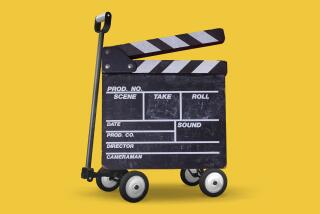Commentary: Streaming TV sparked a creative revolution. Now it’s at risk of losing its edge
This story is part of a Times series on the great streaming wars of 2019. Click here to read the rest of our coverage of Disney +, Apple TV +, HBOMax and more.
Cutting the cord used to feel like cutting loose. Streaming TV promised new faces, new formats, even a new way of watching. But as the upstarts that disrupted the medium become its old guard, and the old guard before that tries to get in on the fun, the streaming vanguard is no more radical than a corporate retreat.
And it might mean a retreat of another sort, as the edgier programming choices of streaming’s halcyon days are supplanted by safer, broader, more traditional TV. Will the end result of the streaming wars be creativity raising the white flag?
It’s a valid concern given that Disney and Apple are launching their own streaming services in a matter of weeks, while WarnerMedia’s HBO Max and NBCUniversal’s Peacock touch down next year.
Subscription TV — the place that gave us the most unconventional programming since local cable — might soon resemble a fifth grader’s birthday party, replete with superheroes, space battles and more branded characters than Comic-Con.
Netflix, Hulu and Amazon Prime, streaming services that ripped up the structure of television and made the niche mainstream, are now threatened by the very change they once implemented. The next wave of media and tech giants to enter a realm at which they once turned up their noses is already making the Big Three (streaming edition) look like quaint upstarts in comparison.
The company that defined the concept of binge watching has continued to reinvent itself. But as Disney, Apple and others enter the streaming business, Netflix faces the biggest challenge in its history.
Disney+ will drop 7,000-plus TV episodes and around 500 movies in its first year alone. It will also boast original productions culled from “Star Wars,” Marvel, Pixar and Disney properties and, wait for it, a “High School Musical” reboot.
Apple TV+ has reportedly sunk at least $1 billion — and possibly $6 billion — into its original content, signing untouchables like Oprah Winfrey, Steven Spielberg and J.J. Abrams as production heavyweights. WarnerMedia, which is owned by AT&T, has a sprawling film archive to draw from, HBO blockbusters like “Game of Thrones” and the security of “Friends” reruns before it even has to churn out a new, prestige drama to be noticed by critics and audiences.
Just when it seemed peak TV’s unofficial motto — more is better — had been pushed to its limits, another deluge is poised to flood the (already saturated) zone.
But the danger isn’t just too much to watch, though my waning muscle mass and tired eyes say otherwise. It’s that the introduction of these behemoths could crush the independent spirit and anything-goes ethos that gave life to anomalies like “Transparent,” “Orange Is the New Black” and “The Handmaid’s Tale,” dramas born out of an industry in flux.
As technological advances reshuffled the traditional network hierarchy, space opened up for risky, untested narratives to flourish. Niche audiences were drawn into various experiments — be it Netflix’s “The OA” and “Stranger Things” or Hulu’s “East Los High” and “The Path” — that needn’t notch the ratings numbers of “The Big Bang Theory” or “NCIS.” (The new guard releases viewership data only selectively, when it does so at all.)
Instead, more and more viewers found something they didn’t even know they were looking for in “Unbreakable Kimmy Schmidt” or “Fleabag,” and were willing to pay for the privilege of watching an entire season in one night. But only if it was worth losing sleep over.
That’s not to say that all (or even most) shows in the peak TV or “platinum” age are bound to be remembered as classics. But when streamers were the outlier, they were eager to carve out their own brand with original programming — and, in order to be seen, were willing to take risks that had previously seemed inconceivable.
Where else but the not-fully-formed world of streaming were women going to get that kind of space and freedom? People of color? Queer people? Not cable. And certainly not the broadcast networks. Case in point: “Orange Is the New Black.”
It sounds silly now, but “OITNB” felt revolutionary when it arrived six years ago. It was like nothing else on television: All-women leads, all women-driven narratives, no major stars to speak of, and all of it set in a prison that looked nothing like “Oz.” Jenji Kohan’s dramedy filled a void for original stories about underrepresented communities on screens big and small, and it did so with emotional depth, acutely developed characters and wicked humor. Russians and Dominicans, black, Latinx and privileged white characters were developed and explored with equal nuance. Imagine that.
The disruption has only snowballed.
“Russian Doll,” starring Natasha Lyonne (who came from from “OITNB,” no less), is about, well, it’s anyone’s guess — but dying over and over again has never been so entertaining. The creators and stars of semi-autobiographical sitcoms like “Master of None” and “Ramy” wouldn’t have stood a chance getting their immigrant or American-Muslim narratives on the same networks who brought us “24” or “Homeland.” While “Jessica Jones” was redefining the anti-heroine, comedies like “PEN15” and “Shrill” were re-imagining her comic counterpart, and “BoJack Horseman” was reinventing the animated series. “Grace & Frankie,” despite resembling broadcast sitcoms, might have taken the biggest leap of all — featuring women over 70 in a comedy with dildo jokes.
Most of this surreal parade could be binge-watched in measured spurts or a feverish bender. No more waiting a week, God forbid. It’s hard to imagine we once had the patience, at least before “OITNB” altered the way we watched television when it debuted in 2013. But streaming has bent our perceptions of what TV is, and should be, with niche content that’s become the new norm. More than that, it raised the bar for the rest of the medium. “Transparent” broke the ice for FX’s “Pose.” “Jessica Jones” paved the way for “Killing Eve.” “The Handmaid’s Tale” spurred the acquisition of enough award-winning literary properties to fill a library.
But while the influx of money, content and clout represented by the start of the so-called streaming wars could mean better TV shows — and more of them — the consolidation of corporate interests might also signal the taming of a wild frontier, and the unparalleled artistic freedom generated in its chaos.
A breakdown of what you need to know about Netflix, Amazon, Hulu, Disney+, Apple TV+, HBO Max, CBS All Access and Peacock.
The future is about as unpredictable as “Westworld,” but the recent evolution of the music industry might provide some clues.
Music enjoyed a creative boom in the 1990s and early 2000s with the emergence of independent rock and hip-hop artists who developed below the radar of pop-pushing labels. Many found a home on independents before the majors moved in thanks to the smell of teen spirit — and money. But the recording industry resisted streaming technology, much like cable and broadcast networks resisted streaming TV, and execs turned to boy bands and Britney Spears to pay the bills. It took well over a decade for the outsider’s ethos to reclaim its small corner of the mainstream.
Television is not immune to the periods of invention and retrenchment that have come to both music and movies — which enjoyed a similar independent flowering in the late 1980s and early ’90s, before it was co-opted by the studios — and the launch of four new major streaming services in the next six months is an important inflection point.
If the programming slates of the the upcoming streaming behemoths are any indication, the future looks ... predictable. After all, there’s been more attention paid to the battle over who gets “Friends,” “Seinfeld” and “The Big Bang Theory” for their back catalogs than buzz over the prospect of the various services’ original programming.
Disney+ is relying on well-known brands to launch its “Star Wars,” Marvel and Pixar verticals, while Peacock plans to reboot beloved series “Battlestar Galactica” and “Saved by the Bell.” HBO Max’s announced original series include a spinoff of “Gossip Girl” and an animated “Gremlins” series. And though none of Apple TV+’s initial, adult-oriented offerings are drawn from pre-existing properties, “The Morning Show,” a #MeToo-themed drama with echoes of the Matt Lauer and Charlie Rose scandals, and “For All Mankind,” a retelling of the moon landing, tread on familiar enough terrain.
Hooray if streaming continues its adventurous run, but it seems just as likely that the streamers will become safe harbor for flat-earth programming, where a handful of gargantuan players exercise tight control over their respective domains. The messy tangle of your old Netflix queue, or the hunt for that hard-to-find British whodunit on Amazon Prime may have become nostalgic relics, akin to a bubble-screen console TV, by the time Disney+ drops its 20th Marvel-themed superhero series.
The revolution is over. Long live the revolution?
More to Read
The complete guide to home viewing
Get Screen Gab for everything about the TV shows and streaming movies everyone’s talking about.
You may occasionally receive promotional content from the Los Angeles Times.








